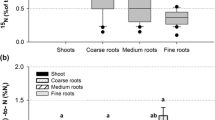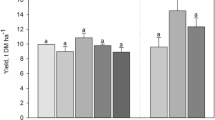Abstract
The residual N contribution from faba bean (Vicia faba L.), pea (Pisum sativum L.) and white lupin (Lupinus albus L.) to microbial biomass and subsequent wheat (Triticum aestivum L.) and oilseed rape (Brassica napus L.) was studied in a greenhouse experiment. The grain legumes were 15N labelled in situ with a stem feeding method before incorporated into the soil, which enables the determination of N rhizodeposition. Wheat and rape were subsequently grown on the soil containing the grain legume residues (incl. 15N-labelled rhizodeposits) and were harvested either twice at flowering and at maturity or once at maturity, respectively. The average total N uptake of the subsequent crops was influenced by the legume used as precrop and was determined by the residue N input and the N2-fixation capacity of the legume species. The succeeding crops recovered 8.6–12.1% of the residue N at maturity. Similar patterns were found for the microbial biomass, which recovered 8.2–10.6% of the residue N. Wheat and rape recovered about the same amount of residue N. The absolute contribution of soil derived N to the subsequent crops was similar in all treatments and averaged 149 mg N pot−1 at maturity. At flowering 17–23% of the residue derived N was recovered in the subsequent wheat and in the microbial biomass; 70% of the residue N was recovered in the microbial biomass in the flowering stage and decreased to about 50% at maturity. In contrast, the recovery in wheat and rape constituted only 30% at flowering and increased to 50% at maturity in all treatments, indicating that the residual N uptake by the subsequent wheat was apparently supplied by mobilisation of residue N temporarily immobilised in the microbial biomass.
Similar content being viewed by others
References
Beck D P, Wery J, Saxena M C and Ayadi A 1991 Dinitrogen fixation and nitrogen balance in cool-season food legumes. Agron. J. 83, 334–341.
Bending G D and Turner M K 1999 Interaction of biochemical quality and particle size of crop residues and its effect on the microbial biomass and nitrogen dynamics following incorporation into soil. Biol. Fertil. Soils 29, 319–327.
Bending G D, Turner M K and Burns I G 1998 Fate of nitrogen from crop residues as affected by biochemical quality and the microbial biomass. Soil Biol. Biochem. 30, 2055–2065.
Blagodatsky S A and Richter O 1998 Microbial growth in soil and nitrogen turnover: A theoretical model considering the activity state of microorganisms. Soil Biol. Biochem. 30, 1743–1755.
Bottner P, Pansu M and Sallih Z 1999 Modelling the effect of active roots on soil organic matter turnover. Plant Soil 216, 15–25.
Bremer E and Van Kessel C 1992a Plant-available nitrogen from lentil and wheat residues during a subsequent growing season. Soil Sci. Soc. Am. J. 56, 1155–1160.
Bremer E and Van Kessel C 1992b Seasonal microbial biomass dynamics after addition of lentil and wheat residues. Soil Sci. Soc. Am. J. 56, 1141–1146.
Brookes P C, Landman A, Pruden G and Jenkinson D S 1985 Chloroform fumigation and release of soil nitrogen: A rapid direct extraction method to measure microbial biomass nitrogen in soil. Soil Biol. Biochem. 17, 837–842.
Cabrera M L and Beare M H 1993 Alkaline persulfate oxidation for determining total nitrogen in microbial biomass extracts. Soil Sci. Soc. Am. J. 57, 1007–1012.
Chalk P M 1998 Dynamics of biologically fixed N in legume-cereal rotation: a review. Aust. J. Agric. Res. 49, 303–316.
Cheng W and Coleman D C 1990 Effect of living roots on the soil organic matter decomposition. Soil Biol. Biochem. 22, 781–787.
Collins H P, Elliott L F, Rickman RW, Bezdicek D F and Papendick R I 1990 Decomposition and Interactions among Wheat Residue Components. Soil Sci. Soc. Am. J. 54, 780–785.
Evans J, McNeill A M, Unkovich M J, Fettell N A and Heenan D P 2001 Net nitrogen balances for cool-season grain legume crops and contributions to wheat nitrogen uptake: a review. Aust. J. Exp. Agr. 41, 347–359.
Goerges T and Dittert K 1998 Improved diffusion technique for 15N:14N analysis of ammonium and nitrate from aqueous samples by stable isotope spectrometry. Commun. Soil Sci. Plant Anal. 29, 361–368.
Haynes R J, Martin R J and Goh K M 1993 Nitrogen fixation, accumulation of soil nitogen and nitrogen balance for some field-grown legume crops. Field Crop. Res. 35, 85–92.
Hood R 2001 Evaluation of a new approach to the nitrogen-15 isotope dilution technique, to estimate crop N uptake from organic residues in the field. Biol. Fertil. Soils 34, 156–161.
Hood R, Merkckx R, Jensen E S, Powlson D, Matijevic M and Hardarson G 2000 Estimating crop N uptake from organic residues using a new approach to the 15N isotope dilution technique. Plant Soil 233, 33–44.
Hood R C, N'Goran K, Aigner M and Hardason G 1999 A comparison of direct and indirect 15N isotope techniques for estimating crop N uptake from organic residues. Plant Soil 208, 259–270.
Høgh-Jensen H and Schjoerring J K 2001 Rhizodeposition of nitrogen by red clover, white clover and ryegrass leys. Soil Biol. Biochem. 33, 439–448.
Jensen E S 1986 Symbiotic N2 fixation in pea and field bean estimated 15N fertilizer dilution in field experiments with barley as reference crop. Plant Soil 92, 3–13.
Jensen E S 1994a Availability of nitrogen in 15N-labelled mature pea residues to subsequent crops in the field. Soil Biol. Biochem. 26, 465–472.
Jensen E S 1994b Dynamics of mature pea residue nitrogen turnover in unplanted soil under field conditions. Soil Biol. Biochem. 26, 455–464.
Jensen E S 1994c Mineralization-immobilization of nitrogen in soil amended with low C:N ratio plant residues with different particle sizes. Soil Biol. Biochem. 26, 519–521.
Jensen E S 1996a Compared cycling in a soil-plant system of pea and barley residue nitrogen. Plant Soil 182, 13–23.
Jensen E S 1996b Rhizodeposition of N by pea and barley and its effect on soil N dynamics. Soil Biol. Biochem. 28, 65–71.
Jensen L S, Mueller T, Magid J and Nielsen N E 1997 Temporal variation of C and N mineralization, microbial biomass and extractable organic pools in soil after oilseed rape straw incorporation in the field. Soil Biol. Biochem. 29, 1043–1055.
Jones D L 1998 Organic acids in the rhizosphere – a critical review. Plant Soil 205, 25–44.
Jörgensen R G 1996 The fumigation-extraction method to estimate soil microbial biomass: Calibration of the k ec value. Soil Biol. Biochem. 28, 25–31.
Jörgensen R G and Müller T 1996 The fumigation-extraction method to estimate soil microbial biomass: Calibration of the k en value. Soil Biol. Biochem. 28, 33–37.
Kaye J P and Hart S C 1997 Competition for nitrogen between plants and soil microorganisms. Trend Ecol. Evol. 12, 139–143.
Korsaeth A, Molstad L and Bakken L R 2001 Modelling the competition for nitrogen between plants and microflora as a function of soil heterogeneity. Soil Biol. Biochem. 33, 215–226.
Kuzyakov Y, Friedel J K and Stahr K 2000 Review of mechanisms and quantification of priming effects. Soil Biol. Biochem. 32, 1485–1498.
Marschner H 1995 Mineral Nutrition of Higher Plants. Academic Press, London.
Mayer J, Buegger F, Jensen E S, Schloter M and Heß J 2003 Estimating N rhizodeposition of grain legumes using a 15N in situ stem labelling method. Soil Biol. Biochem. 35, 21–28.
McNeill A M, Zhu Ch and Fillery I R P 1998 A new approach to quantifying the N benefit from pasture legumes to succeeding wheat. Aust. J. Agric. Res. 49, 427–436.
Müller T, Jörgensen R G and Meyer B 1992 Estimation of soil microbial biomass C in the presence of living roots by fumigationextraction. Soil Biol. Biochem. 24, 179–181.
Myers R J K, van Noordwijk M and Vityakon P 1997 Synchrony of nutrient release and plant demand: plant litter quality, soil environment and farmer management options. In Driven by Nature – Plant Litter Quality and Decomposition. Eds. Cadisch G and Giller K E. pp. 215–229. CAB International, Wallingford.
Olfs H-W and Scherer H W 1996 Estimating microbial biomass N in soils with and without living roots: Limitations of a pre-extraction step. Biol. Fertil. Soils 21, 314–318.
Russell C A and Fillery I R P 1996a Estimates of lupin belowground biomass nitrogen, dry matter, and nitrogen turnover to wheat. Aust. J. Agric. Res. 47, 1047–1059.
Russell C A and Fillery I R P 1996b In situ 15N labelling of lupin below-ground biomass. Aust. J. Agric. Res. 47, 1035–1046.
Russell C A and Fillery I R P 1999 Turnover of nitrogen from components of lupin stubble to wheat in sandy soil. Aust. J. Agr. Res. 37, 575–592.
Sawatsky N and Soper R J 1991 A quantitative measurement of the nitrogen loss from the root system of field peas (Pisum avense L.) grown in the soil. Soil Biol. Biochem. 23, 255–259.
Schinner F, Öhlinger R, Kandeler E and Margesin R 1996 Methods in Soil Biology. Springer Verlag, Berlin, Heidelberg, New York. 426 p.
Schmidtke K 1996 Methodik zur Ermittlung der N-Flächenbilanz beim Anbau von Leguminosen. Mitt. Ges. Pflanzenbauw. 9, 43–44.
Senaratne R and Hardarson G 1988 Estimation of residual N effect of faba bean on two succeeding cereals using 15N methodology. Plant Soil 110, 81–89.
Smith B J and Kirkegaard J A 2002 In vitro inhibition of soil microorganisms by 2-phenylethyl isothiocyanate. Plant Pathol. 51, 585–593.
Stevenson F C and Van Kessel C 1997 Nitrogen contribution of pea residue in a hummocky terrain. Soil Sci. Soc. Am. J. 61, 494–503.
Stevenson F C, Walley F L and Van Kessel C 1998 Direct vs. indirect nitrogen-15 approaches to estimate nitrogen contributions from crop residues. Soil Sci. Soc. Am. J. 62, 1327–1334.
Stülpnagel R 1982 Schätzung der von Ackerbohnen symbiontisch fixierten Stickstoffmenge im Feldversuch mit der erweiterten Differenzmethode. Z. Acker Pflanzenbau 151, 446–458.
Van der Krift T A J, Gioacchini P, Kuikman P J and Berendse F 2001 Effects of high and low fertility plant species on dead root decomposition and nitrogen mineralisation. Soil Biol. Biochem. 33, 2115–2124.
Van Soest P J 1963 Use of detergents in the analysis of fibrous feeds. II. A rapid method for the determination of fiber and lignin. J. Assoc. Off. Anal. Chem. 46, 829–835.
Vance E D, Brookes P C and Jenkinson D S 1987 An extraction method for measuring soil microbial biomass C. Soil Biol. Biochem. 19, 703–707.
Zagal E 1994 Influence of light intensity on the distribution of carbon and consequent effects on mineralization of soil nitrogen in a barley (Hordeum vulgare L.)-soil system. Plant Soil 160, 21–31.
Zebarth B J, Alder V and Sheard R W 1991 In situ labeling of legume residues with a foliar application of a 15N-enriched urea solution. Commun. Soil Sci. Plant Anal. 22, 437–447.
Author information
Authors and Affiliations
Rights and permissions
About this article
Cite this article
Mayer, J., Buegger, F., Jensen, E.S. et al. Residual nitrogen contribution from grain legumes to succeeding wheat and rape and related microbial process. Plant and Soil 255, 541–554 (2003). https://doi.org/10.1023/A:1026081015076
Issue Date:
DOI: https://doi.org/10.1023/A:1026081015076




